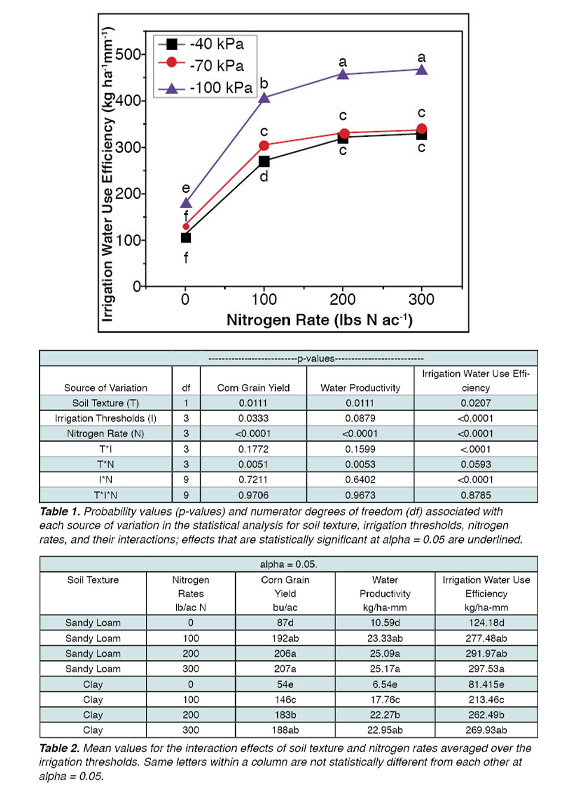Research Project
Irrigation Threshold and Nitrogen Rate Effects on Corn Water Use and Yield Response
Investigators: Gurbir Singh, Amilcar Vargas, Gurpreet Kaur
Date: 2021
Project Summary
Introduction
With the overuse and excessive pumping of the groundwater there is a need to use irrigation systems that are more efficient in water application and at the same time reduce drawdown of the groundwater. There is limited research available on the use of overhead irrigation systems in corn production systems in the Mississippi Delta. Therefore, understanding the relation between overhead irrigation scheduling with soil series, soil nutrients, and plant environment are essential for the effective management of corn grown under overhead irrigation systems in this region. Previous studies from the Corn Belt region of the US have reported interactions between irrigation applications, available soil water content, and nitrogen (N) rates on corn productivity. Soil texture and soil water content have been reported previously to play a very strong role in dictating irrigation and N management practices for corn production. The overall objective of this study was to evaluate the effects of sensor-based irrigation with different N rates on corn yield and yield components. We hypothesized that drier irrigation thresholds (-70 and -100 kPa) would be ideal for irrigating corn grown on 2:1 Tunica clay soils whereas these thresholds will negatively affect corn yield on Bosket very fine sandy loam soils.
Materials and Methods
This study was conducted at Delta Research and Extension Center, Mississippi State University, Stoneville, MS, in 2021. Treatments included in this study were three irrigation scheduling thresholds (-40, -70, and -100 kPa) and a rainfed treatment, four N application rates (0, 100, 200, and 300 lb/ac N), and two distinct soil textural classes (sandy loam and clay). The treatment design was a factorial design with main factors of soil textural class and irrigation thresholds and split factor of nitrogen rates. All treatments were replicated five times. The plot size for individual N rate treatment was 27 feet × 50 feet. In total there were 160 plots. The irrigation scheduling method consisted of the sensor-based irrigation scheduling method based on soil matric potential values recorded by soil moisture sensors installed in the field. The Watermark soil water sensors were installed at three depths: 6”, 12”, and 24”. For irrigation scheduling, whenever the weighted average sensor reading reached the designated irrigation threshold of the plot, irrigation was applied to the plot. During the corn growing season, data on irrigation water applied and precipitation received were collected using flowmeters and rain gauge, respectively. Crop growth data including plant height, plant population, and SPAD chlorophyll meter reading were also collected during the growing season. At physiological maturity, corn biomass was collected to estimate N uptake in irrigation and N rate treatments. Two rows of corn were harvested using a Kinkaid 8XP plot combine equipped with a H2 harvest master grain gauge for estimating corn grain yields. At the time of harvesting, grain samples were also collected for N uptake and grain quality analysis. Corn grain yield was adjusted to 15.5% moisture for reporting. The irrigation and precipitation data were used to calculate agronomic water productivity and irrigation water use efficiency. Results were analyzed using the GLIMMIX procedure in SAS statistical software at alpha = 0.05.
Results and Discussion
Corn grain yield was affected by irrigation thresholds (Table 1), with -70 kPa irrigation threshold yielding 165 bu/ac when averaged over soil texture and nitrogen application rates. Corn yield for the -70 kPa irrigation threshold was not statistically different from the -100 kPa irrigation threshold (158 bu/ac) however it was at least 8 bu/ac greater compared to rainfed and -40 kPa treatments. When averaged by irrigation thresholds, the highest corn grain yield was 206 and 207 bu/ac for sandy loam soil at 200 and 300 lb/ac N rates (Table 2), respectively. Similarly, for clay soil, the highest yields of 183 and 188 bu/ac were achieved with 200 and 300 lb/ac N rates. The three-way interaction between soil texture, irrigation thresholds, and N rate was not statistically significant. Irrigation water use efficiency when averaged over soil texture was highest for -100 kPa irrigation treatment with 200 and 300 lb/ac N rates (Figure 1). At the -70 kPa irrigation threshold, the irrigation water use efficiency was similar for all N rates except the 0 lb/ac control (Figure 1).
Project Photos

- Crop Type:
- Corn
- Topic:
- Irrigation Scheduling
- Soil
- Irrigation
Find Research
By Crop Type
By Topic
Contact NCAAR
General Information
Kaye Sullivan
vfs23@msstate.edu
662.390.8510
F:662.390.8501
Showcase Demo
Drew Gholson, Coordinator
drew.gholson@msstate.edu
662.390.8505
Himmy Lo
himmy.lo@msstate.edu
662.390.8509

